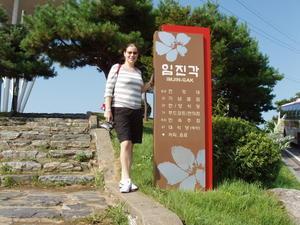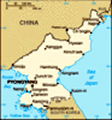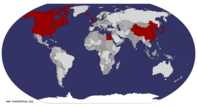Advertisement
Published: August 28th 2006

 Imgingak Park
Imgingak Park
Posing in front of the welcome signAs the title of this entry suggests, I ventured into the "Demilitarized" zone between North and South Korea.
Eve and I booked a tour to the DMZ (as it is lovingly referred to) after reading the fine print of the brouchure which basically told us its not the tour companiy's fault if we were to be shot in case conflict broke out in the DMZ- a rare occurence, but with heightened tensions between the Koreas and the fact that the North and South had a shooting incident for the first time in a few years just a week or so before we arrived, the tour company wanted us to make sure that we all understood we were in an actively patrolled zone. We also weren't allowed to wear mini-skirts.
This trip to the DMZ was one of the highlights of our entire vacation. The Military Demarcation line is surrounded by Demilitarized Zone under the provision of Armistice(cease-fire) Agreement made in July, 1953. Military Demarcation runs 155miles and separates South and North We started off at Imjingak Park which was built in 1972 with the hope that unification would be possible one day as it would serve as a prime
metting place for families from the North and South. The Bridge of Freedom is also here which was used by Southerners to return to the South from the North and which is now closed and covered with prayer offerings for families separated by the border.
After the park, we boarded a military bus and made our way across the broder into the DMZ. A soldier came on the bus to check all of our passports and make sure we weren't spies. O nce we boarded the bus is where the photography ban kicked in- we weren't allowed to take any unauthorized pictures of anything out the window or in the bus itself. We passed by concrete overpasses that were constructed to house ammunition and dynamite in case the North tried to invade the South, the South will detonate these overpasses and effectively block the roads to Seoul. So somewhere you don't really feel comfortable driving by. Our first stop was Doarsan train station.
Dorasan Station is the closest train station to the border of North Korea. And its famous for not being used- its open, but there are no trians. It stands to wait for unification between the

 Freedom Bridge and the Memorial
Freedom Bridge and the Memorial
The view of Freedom Bridge from atop the observatory at Imgingak ParkKoreas. It was also here that we got our first glimpse of the bitterness and hatred the South had for the North, specifically through our tour guide, a theme that would be echoes later through thte various museum displays we saw specifically detailling how North Koreans are "liars." Apparently, the North keeps stalling on the constrction of their sister station on the other side of teh DMZ claiming lack of money, workers, and materials. Doarsan is meant to one day connect with the Northern capital, Pyongyang. The stations big claim to fame is how George W. Bush visited the site in 2002 and made a speech- something that Eve and I were not interested in, nor were we interested in looking at the pictures of George W. in the station. Instead, we amused ourselves with the guards on duty and posed for pictures with them.
After Dorasan, it was back on the bus and over to the real highlight of the tour- the 3rd Inflitration Tunnel. Unfortunately, this is another place where pictures are completely forbidden, which is a shame. From the official website:
"The 3rd Tunnel was discovered on October 17, 1978. It is located 52km from Seoul.

 Guard Post
Guard Post
From the observaroty, guard posts can be seen along the DMZ and fenceApproximately 10,000 soldiers can move through this tunnel in one hour.
When this tunnel was discovered, North Koreans insisted steadfastly that it was made by South Koreans to invade North Korea, but this proved to be false."
To enter the tunnel itself, you have to walk 300m down a steep incline after first being fitted with a yellow hard hat, which came in handy. Although I'm barely 5'7, I had to duck my head and crouch in some spots, but I still managed to bang my hard hat on some pipes and scrape it along the ceiling of the tunnel. Judging from the scraped helmets, I wasn't the first one to do this. If you're tall, this is a place you might want to rethink a visit to if you can't walk hunched over for a stretch of time. The tunnel was cool, dark, and damp as water dripped from overhead and was filtered into metal bowls to drain off of the "path." The dynamite marks were spray painted yellow with placards detailing how the tunnel was in fact dug by the North as the dynamite charges were detonated from the Northern side. You can make it all the

 DMZ fence
DMZ fence
If this doesn't mean "Keep Out", I don't know what doeswya to the end of the path which is about 140m from the actual North border and is blocked off with a soldier and rows of barbed wire. Its as close to the North as you can get from this point in the South. Then it was time to turn around, walk the length of the tunnel again and hike back up the steep 300m incline. I had never been more grateful for my purchse of new running shoes the day before.
Across from the tunnel is an interactive museum detailing the conflict between the Koreas as well as a short documentary film on the DMZ which is a wildlife sanctuary since it has been free to run wild since the 1950s without human intervention. Our next stop was Dora Observatory.
From here, we were briefed by the military as we had our first glance of North Korea and instructed not to take any pictures or they would destory our film or erase digital pictures. We were ushered outside to the viewing platform and told that we could take pictures from behind the yellow line. This photo line was a bit of a joke since it is far

 Bell Pavillion
Bell Pavillion
A pece bell is housed in this pavillionenough removed from the edge of the observatory that if you're anywhere under 5'6 or lack a good zoom lens on your camera, you'r eleft without photos. Luckily, being a bit taller than the other tourists, I was able to hold my camera over my head, zoom in, and randomly snap pictures for myself and Eve, who, as almost half a foot shorter than I am, wasn;t able to get much of anything. We used the binoculars at the observatory to look over at the closest Northern city, Gaesong, and the closest village in the Northern part of the DMZ, "Propaganda Village." People do live in the DMZ on the Southern half but are under strict curfew and have to return to their village by 10pm each night. As an incentive to living here, the residents don't pay taxes. We were also told that here are only 8 chilren who live in the village.
The view of the North was beautiful- there are many mountains and lush greenery with a large and prominent North Korean flag flying high, just in case you forgot which direction you were looking.
After the requsite stop at an amethyst jewellery store (I

 Peace Bell
Peace Bell
Close-up of the Peace Bellstayed in the bus to have a nap), we were back in Seoul on our own for lunch, the whole tour having taken a mere 5 hours.
After lunch at one of the many Dunkin' Donuts (hey, I've been in Japan and have been missing donuts for 4 months) we checked out the
Chongdong Theatre in order to return for a show that evening. The Chongdong Theatre has daily performances of traditional Korea music and dance. For a very reasonable $16- far less than it cost for me to see "Pirates of the Caribbean 2" at the local Fukushima theatre- we were trated to 6 different traditional Korean perforamnces with the help of a handy English translator that gave us the background information and storyline.
Our program included, with info from the theatre's website:
Shinawi concert and dance- Shinawi concert is the purest form of traditional Korean music that thrives on the improvisational skills and excitement of the players and is supposed to represent flowing water. A group of male and female performaers play instruments whil ea woman dances in the background.
Pansori- Appointed as a World Cultural Heritage in 2003 by UNESCO, Pansori is a genre of

 Dorasan Station
Dorasan Station
Me in front of Dorasan Station...the outside was much more interesting than the insidetraditional Korean art that best represents Korea. Composed of a ‘soriggun’, who delivers the lines, vocal music, and gestures to the audiences and a ‘gosu’, who increases the emotionality of soriggun’s performance by playing a drum next to him, it is an exciting and vital occasion that binds all the players and audiences in one. It was a very moving performance given by the female vocalist.
Samogomu- by far my favourite of the performances. 7 women each with 3 standing drums play simultaneously as they bend over backwards and turn, all in unision. It was dance and music in one.
Taepyeongu & Pangut and Sogochum- Type sof Korean dance performed by men and women in traditional costume. The men leap and jump with ribbons attacted to their heads while playing drums while the women's dance is much more slow and refined, focussing on the movements of the feet and legs.
There was also traditional chamber music.
After the show we went over to Sinchon for some dinner- a traditional Korean squid pancake/pizza thong which was actualoly pretty tasty. We were told that Sinchon had a nightlife so we were keen to explore the area and sample

 With the guard...
With the guard...
in Dorasan Stationa bit of the clubs and bars since we can't do that in Fukushima. Having a particular and similar taste in music we figured we would be able to find something enjoyable to listen to. We started by visiting the bars with the promising names: The London Underground, Rolling Stone, Rock and Roll Bar, etc. Each place we stuck our heads into was empty. We were shocked. There was either a single customer or no one at all, although it was approaching midnight. Confused, we kept walking the streets. That's when I spotted something that looked promising: a bar called River Phoenix, named after the actor. I stopped to take a picture of the sign and head the music they were playing, my all-time favourite band, U2, I took it as a sign that this was the place. Even the poster of Michael Bolton at the entrance didn't deter me, since it was afterall, next to a poster of my other favourite band, Franz Ferdiannd. An odd combination or posters, but one worth checking out anyway. W eweren't disappointed.
The bar was an "all request" video bar. The tables and couches were set up to face a large video

 3rd Infiltration Tunnel
3rd Infiltration Tunnel
Eve and I in our hard hats at the entrance to the 3rd Tunnelscreen on the wall that was playing an old U2 concert. The best part was, we weren't the only ones in there- there were 2 men singing along to the video. The walls were covered in movie and music posters, albums, and lights. I told Eve that this is what the inside of my head must look like- filled with random song lyrics, music and movie information. The bar was a "help yourself" kind where you pulled out whatever kind of bottled beer you wanted while the owner played a variety of music videos and albums. Another cool thng about Korean bars is that you get a platter of snacks for free so we happily drank our beer- I opted for the Tiger beer from S.E. Asia- and ate our snacks.
After an hour or so, the bar's 2 other customers came over, introduced themselves and sat down where we spent the rest of the night chatting away about music, Japan, Canada, and Korea. Our new friends, Mr. Kim and "Moon over the Water" were even more excited when we all discovered Molson Canadian beer at the bar and all drank to Canada. The owner eventually came over, as
did the sole staff member and we all sat around chatting away. Eventually, they told us ot pay and leave since it was clear no one else would be coming to the bar, so we went to karaoke with our new friends. Japanese karaoke is far superior to its Korean counterpart, but we stil had a great time, making it back to our hotel by 430am, much to the delight and surprise of the hostel staff who knew us by name- sitting in a big group outside the entrance on the hostel's patio, they took turns saying "Goodnight" and "Goodmorning" to us.
And so comes the end to a very long day and a very long post.
Advertisement
Tot: 0.191s; Tpl: 0.029s; cc: 10; qc: 28; dbt: 0.1285s; 1; m:domysql w:travelblog (10.17.0.13); sld: 1;
; mem: 1.1mb



















